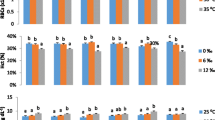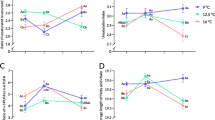Abstract
Simultaneous, 6-week feeding trials were conducted in which diets containing menhaden, corn, coconut and hydrogenated menhaden oil at 7.0%, plus a diet containing 14% menhaden oil, were fed to triplicate groups of juvenile red drum (Sciaenops ocellatus) at two different salinities (5 and 32%.). Weight gain was significantly (p < 0.05) affected by diet and salinity. Fish fed the diet containing 14% menhaden oil had the greatest weight gain; whereas, fish fed the diet containing coconut oil gained the least weight. Fish in brackish water had significantly greater weight gain than fish in full-strength seawater over the 6-week period, although fish fed coconut and saturated menhaden oil in brackish water had reduced survival. Dietary lipid also significantly affected muscle and liver total lipid, hepatosomatic index (HSI), and intraperitoneal fat (IPF) ratio, as fish fed the diets containing 14% menhaden oil had higher values for all of these body condition indices.
After the feeding trial, fish were subjected to a chronic cold tolerance assay. In the chronic trial, where temperature was gradually reduced over a 3-week period, fish fed the diets containing menhaden oil had significantly lower median lethal temperatures (MLT) than those fish fed the diets containing coconut, corn and saturated menhaden oils. No significant effects of cold exposure were observed on muscle and liver total lipid. Cold exposure prompted a modification in lipid metabolism by lowering total saturated fatty acids and raising (n − 3) highly unsaturated fatty acids (HUFA) in the neutral lipid of liver. Fish with the lowest MLT in the chronic assay exhibited signs of conserving (n − 3) HUFA and depleting (n − 6) fatty acids [primarily 18:2 (n − 6)], resulting in higher (n − 3)/(n − 6) ratios in the polar lipid of liver. These data suggest that the lower lethal temperature of juvenile red drum can be reduced through dietary manipulation involving the inclusion of high levels of dietary lipid rich in (n − 3) HUFA.
Similar content being viewed by others
References cited
Bazaz, M.M. and Keshavanath, P. 1993. Effect of feeding different levels of sardine oil on growth, muscle composition and digestive enzyme activities of mahseer, Tor khudree. Aquaculture 115: 111–119.
Bell, M.V., Henderson, R.J., Pirie, B.J.S. and Sargent, J.R. 1985. Effects of dietary polyunsaturated fatty acid deficiencies on mortality, growth, and gill structure in the turbot Scophthalmus maximus. J. Fish Biol. 26: 181–191.
Bell, M.V., Henderson, R.J. and Sargent, J.R. 1986. The role of polyunsaturated fatty acids in fish. Comp. Biochem. Physiol. 83B: 711–719.
Borlongan, I.G. and Benitez, L.V. 1992. Lipid and fatty acid composition of milkfish (Chanos chanos Forsskal) grown in freshwater and seawater. Aquaculture 104: 79–89.
Castledine, A.J. and Buckley, J.T. 1980. Distribution and mobility of ω 3 fatty acids in rainbow trout fed varying levels and types of dietary lipid. J. Nutr. 110: 675–685.
Cowey, C.B., Adron, J.W., Owens, J.M. and Roberts, R.J. 1976. The effects of different dietary oils in tissue fatty acids and tissue pathology in turbot (Scophthalmus maximus). Comp. Biochem. Physiol. 53B: 399–403.
Craig, S.R. 1994. Dietary manipulation of lipid deposition and cold tolerance in juvenile red drum, Sciaenops ocellatus. Ph.D. Dissertation, Texas A&M University.
Daikoku, T., Yano, I. and Masui, M. 1982. Lipid and fatty acid composition and their changes in the different organs and tissues of guppy, Poecilia reticulata on seawater adaptation. Comp. Biochem. Physiol. 73A: 167–174.
Dean, J.M. 1969. The metabolism of tissues of thermally acclimated trout (Salmo gairdneri). Comp. Biochem. Physiol. 29: 185–196.
Ellis, S.C. and Reigh, R.C. 1991. Effects of dietary lipid and carbohydrate levels on growth and body composition of juvenile red drum, Sciaenops ocellatus. Aquaculture 97: 383–394.
Farkas, T. 1979. Adaption of fatty acid compositions to temperature — a study of planktonic crustaceans. Comp. Biochem. Physiol. 64B: 71–76.
Folch, J., Lees, M. and Sloane-Stanley, G.H. 1957. A simple method for the isolation and purification of total lipides from animal tissues. J. Biol. Chem. 226: 497–509.
Fujii, D.K. and Fulco, A.J. 1977. Biosynthesis of unsaturated fatty acids by Bacilli — hyperinduction and modulation of desaturase synthesis. J. Biol. Chem. 252: 3660–3670.
Fujii, M. and Yone, Y. 1976. Studies on the nutrition of red sea bream XIII. Effects of dietary linolenic and omega-3 polyunsaturated fatty acids on growth and feed efficiency. Bull. Jap. Soc. Sci. Fish. 42: 583–588.
Gatlin, D.M., III., MacKenzie, D.S., Craig, S.R. and Neill, W.H. 1992. Effects of dietary sodium chloride on red drum juveniles in waters of various salinities. Prog. Fish Cult. 54: 220–227.
Greene, D.H.S. and Selivonchick, D.P. 1987. Lipid metabolism in fish. Prog. Lipid Res. 26: 53–85.
Hanley, F. 1991. Effects of feeding supplementary diets containing varying levels of lipid on growth, food conversion, and body composition of Nile tilapia, Oreochromis niloticus (L). Aquaculture 93: 323–334.
Hagar, A.F. and Hazel, J.R. 1985. Changes in desaturase activity and the fatty acid composition of microsomal membranes from liver tissue of thermally-acclimating rainbow trout. J. Comp. Physiol. B. 156: 35–42.
Hazel, J.R. 1979. The influence of temperature adaptation on the composition of the neutral lipid fraction of rainbow trout (Salmo gairdneri) liver. J. Exp. Zool. 207: 33–42.
Hazel, J.R. 1984. Effects of temperature on the structure and metabolism of cell membranes inn fish. Am. J. Physiol. 246: R460–R470.
Jezierska, B., Hazel, J.R. and Gerkin, S.D. 1982. Lipid mobilization during starvation in the rainbow trout, Salmo gairdneri Richardson, with attention to fatty acids. J. Fish Biol. 21: 681–692.
Kanazawa, A., Teshima, S. and Ono, K. 1979. Relationship between essential fatty acid requirements of aquatic animals and the capacity for bioconversion of linolenic acid to highly unsaturated fatty acids. Comp. Biochem. Physiol. 63B: 295–298.
Lochmann, R.T. and Gatlin, III. 1993. Essential fatty acid requirements of the red drum, Sciaenops ocellatus. Fish Physiol. Biochem. 12: 221–235.
Lovel, R.T. 1989. Nutrition and Feeding of Fish. Van Nostrand Reinhold, New York.
McCormick, S.D., Saunders, R.L. and MacIntyre, A.D. 1989. The effect of salinity and ration level on growth rate and conversion efficiency of Atlantic salmon (Salmo salar) smolts. Aquaculture 82: 173–180.
McKay, L. and Gjerde, B. 1985. The effect of salinity on growth of rainbow trout. Aquaculture 49: 325–331.
Moon, H.Y. and Gatlin, D.M. III. 1991. Total sulfur amino acid requirement of juvenile red drum, Sciaenops ocellatus. Aquaculture 95: 97–106.
Morgan, J.D. and Iwama, G.K. 1991. Effect of salinity on growth, metabolism, and ion regulation in juvenile rainbow and steelhead trout (Oncorhynchus mykiss) and fall chinook salmon (Oncorhynchus tshawytscha). Can. J. Fish. Aquat. Sci. 48: 2083–2094.
Moser, M.L. and Hettler, W.F. 1989. Routine metabolism of juvenile spot, Leiostomas xanthurus (Lacèpède), as a function of temperature, salinity and weight. J. Fish Biol. 35: 703–707.
Nematipour, G.R., Brown, M.L. and Gatlin, D.M., III. 1992. Effects of dietary carbohydrate: lipid ratio on growth and body composition of hybrid striped bass. J. World Aquacult. Soc. 23: 128–132.
Ostrowski, A.C. and Divakaran, S. 1990. Survival and bioconversion of n−3 fatty acids during early development of dolphin (Coryphaena hippurus) larvae fed oil-enriched rotifers. Aquaculture 89: 273–285.
Owen, J.M., Adron, J.W., Middleton, C. and Cowey, C.B. 1975. Elongation and desaturation of dietary fatty acids in turbot, Scophthalmus maximus L, and rainbow trout, Salmo gairdnerii Rich. Lipids 10: 528–531.
Procarione, L.S. 1986. Ultimate lower lethal temperature of red drum Sciaenops ocellatus as a function of water hardness and salinity. M.S. Thesis, Texas A&M University, USA.
SAS Institute, Inc. 1985. SAS Users Guide: Statistics, Version 5 Edition, Cary.
Satoh, S., Poe, W.E. and Wilson, R.P. 1989. Effect of dietary n−3 fatty acids on weight gain and liver polar fatty acid composition of fingerling channel catfish. J. Nutr. 119: 23–28.
Schünke, M. and Wodtke, E. 1983. Cold-induced increase of δ9- and β6-desaturase activities in endoplasmic membranes of carp liver. Biochim. Biophys. Acta 734: 70–75.
Sellner, P.A. and Hazel, J.R. 1982. Incorporation of polyunsaturated fatty acids into lipids of rainbow trout hepatocyes. Am. J. Physiol. 243: R223–R228.
Serrano, J.A., Nematipour, G.R. and Gatlin, D.M., III. 1992. Dietary protein requirement of the red drum (Sciaenops ocellatus) and relative use of dietary carbohydrate and lipid. Aquaculture 101: 283–291.
Sheridan, M.A. 1988. Lipid dynamics in fish: aspects of absorption, transportation, deposition and mobilization. Comp. Biochem. Physiol. 90B: 679–690.
Sinensky, M. 1974. Homeoviscous adaptation — a homeostatic process that regulates viscosity of membrane lipids in Escherichia coli. Proc. Nat. Acad. Sci., U.S.A. 71: 522–525.
Skuladottir, G.V., Schiöth, H.B., Gudmundsdottir, E., Richards, B., Gardarsson, F. and Jonsson, L. 1990. Fatty acid composition of muscle, heart and liver lipids in Atlantic salmon, Salmo salar, at extremely low environmental temperature. Aquaculture 84: 71–80.
Stauffer, J.R. Jr. 1986. Effects of salinity on preferred and lethal temperatures of the Mozambique tilapia, Oreochromis mossambicus (Peters). Water Res. Bull. 22: 205–208.
Stowell, S. and Gatlin, D.M., III. 1992. Effects of dietary pantethine and lipid levels on growth and body composition of channel catfish Ictalurus punctatus. Aquaculture 108: 177–188.
Wakeman, J.M. and Wohlschlag, D.E. 1983. Time course of osmotic adaptation with respect to blood serum osmolality and oxygen uptake in the euryhaline teleost, Sciaenops ocellatus (red drum). Contrib. Mar. Sci. 26: 165–177.
Watanabe, T., Takeuchi, T., Arakawa, T., Imaizumi, K., Sekiya, S. and Kitajima, C. 1989. Requirement of juvenile striped jack Longirostris delicatissimus for n−3 highly unsaturated fatty acids. Nippon Suisan Gakkaishi 55: 1111–1117.
Williams, C.D. and Robinson, E.H. 1988. Response of red drum to various dietary levels of menhaden oil. Aquaculture 70: 107–120.
Author information
Authors and Affiliations
Rights and permissions
About this article
Cite this article
Craig, S.R., Neill, W.H. & Gatlin, D.M. Effects of dietary lipid and environmental salinity on growth, body composition, and cold tolerance of juvenile red drum (Sciaenops ocellatus). Fish Physiol Biochem 14, 49–61 (1995). https://doi.org/10.1007/BF00004290
Accepted:
Issue Date:
DOI: https://doi.org/10.1007/BF00004290




